Frenett heat pump: device and principle of operation + can you assemble it yourself?
Lovers of tinkering will always find application in their own strength, patience and waste materials. Of the almost free components, they can easily build an extremely useful thing in everyday life.
For example, they can make an effective Frenett heat pump with their own hands, without spending anything. But they will replenish the store of knowledge and stock of skills, and this is priceless, is it not so?
The information provided will help to understand the principle of operation of the unit. With our help, you can determine the design and find out how the model is made. Clear instructions for the production of this type of heat pump will effectively help independent home craftsmen.
We provide practical recommendations for the production of productive home-made products and tips on the operation of such equipment.
The content of the article:
The principle of operation of the device
Those who come into contact with issues of cost-effective heating, the name "heat pump" is well known. Especially in combination with land-water terms, Water-to-water, or Air-to-water etc.
Such a heat pump with a Frenett device has practically nothing in common. In addition to the name and the final result in the form of thermal energy, which is ultimately used for heating.
Carnot-based heat pumps are very popular both as a cost-effective way of organizing heating and as an environmentally friendly system.
The work of such a complex of devices is associated with the accumulation of low potential energy contained in natural resources (earth, water, air), and its conversion into heat energy with a high potential.
Eugene Frenett’s invention is arranged and works in a completely different way.
The principle of operation of this device is based on the use of thermal energy, which is released during friction. The design is based on metal surfaces located not close to each other, but at a certain distance. The space between them is filled with liquid.
Parts of the device rotate relative to each other using an electric motor, the fluid inside the housing and in contact with the rotating elements is heated.
The resulting heat can be used to heat the coolant. Some sources recommend using this fluid directly for the heating system. Most often, a conventional radiator is attached to a home-made Frenett pump.
As coolant heating system experts strongly recommend using oil rather than water.
During the operation of the pump, this fluid tends to heat up very strongly. Water in such conditions can simply boil. Hot steam in an enclosed space creates excessive pressure, and this usually leads to rupture of the pipes or casing. Using oil in this situation is much safer, because its boiling point is much higher.

There is an opinion that the efficiency of such a heat generator exceeds 100% and may even be 1000%. From the point of view of physics and mathematics, this is not a completely correct statement.
Efficiency reflects the energy loss spent not on heating, but on the actual operation of the device. Rather, the phenomenal claims about the incredibly high efficiency of the Frenett pump reflect its effectiveness, which is really impressive. The cost of electricity for the operation of the device is negligible, but the amount of heat obtained as a result is very noticeable.
Heating a coolant to the same temperatures with the help of a heating element for heating, for example, would require a much larger amount of electricity, possibly tens of times more. A household heater would not even heat up with such an electricity consumption.
Why are all residential and industrial premises not equipped with such devices? The reasons may be different.
Firstly, water is a simpler and more convenient heat transfer medium than oil. It does not heat up to such high temperatures, and eliminating the effects of water leaks is easier than removing spilled oil.
SecondlyBy the time the Frenett pump was invented, a centralized heating system already existed and was functioning successfully. Dismantling it for replacement with heat generators would be too expensive and would cause a lot of inconvenience, so no one even seriously considered this option. As the saying goes, the best is the enemy of the good.
Instrument Use Recommendations
It is worth noting that the variations of the Eugene Frenett pump using water as a coolant still exist. But usually these are large industrial models that are used in specialized enterprises.
The operation of such devices is strictly controlled using special devices.Providing a similar level of safety at home is almost impossible.

The most popular version of the Frenett pump, which uses water rather than oil as the coolant, is a device developed by scientists from Khabarovsk: Nazyrova Natalya Ivanovna, Leonov Mikhail Pavlovich and Syarg Alexander Vasilyevich. In this mushroom-shaped design, water is specially brought to a boil and converted into steam.
Then the reactive force of the steam is used to increase the speed of movement of the liquid coolant along the pump channels to 135 m / min. As a result, energy costs for moving the coolant are minimal, and the return in the form of thermal energy is very high.
However, such an assembly must be exceptionally robust, and its operation should be constantly monitored to avoid an accident.
What to do if with the help of the Frenett pump it is supposed to organize heating of a large room or the whole house? Water is a traditional heat carrier; most heating systems are designed specifically for it. And filling an entire heating system with suitable liquid oil can be expensive.
This issue is solved very simply. It is necessary to additionally build a conventional heat exchanger, in which the heated oil will heat the water circulating through the heating system. At the same time, some heat will be lost, but the overall effect will remain quite noticeable.
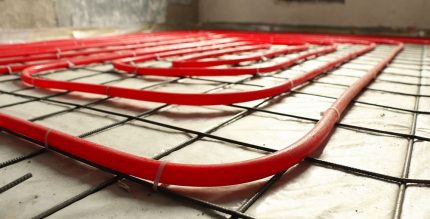
An interesting idea would be to use a Frenett pump in combination with floor heating system. In this case, the coolant is let through narrow plastic pipes laid in a concrete screed.
Such a heating system functions in the same way as an ordinary water floor heating. Of course, a project of this type can only be implemented in a private house, since it is allowed to use exclusively for high-rise apartment buildings electric underfloor heating.
A practical and convenient way to use such a device is to heat a small room: a garage, a barn, a workshop, etc. The Frenett pump allows you to efficiently and quickly solve the problem of autonomous heating in such places.
The cost of electricity for its operation is small compared with the resulting thermal effect, and to build such an aggregate is not difficult from the simplest materials.
Frenett Pump Design Options
Eugene Frenett not only invented the device named after him, but also repeatedly improved it, coming up with newer, more efficient versions of the device.
In the very first pump, which the inventor patented in 1977, only two cylinders were used:
- outer - the hollow cylinder is larger in diameter and is in a static state
- interior - the diameter of the container is slightly smaller than the dimensions of the cavity of the outer cylinder.
The inventor poured liquid oil into the resulting narrow space between the walls of two cylinders. Of course, that part of the structure in which this liquid coolant was located was carefully sealed to prevent oil leakage.
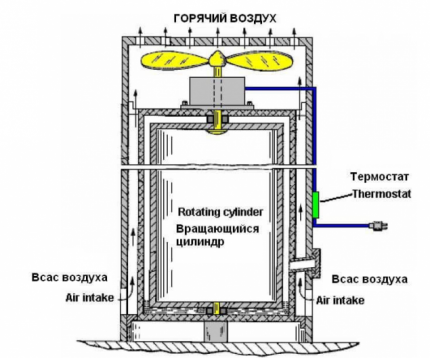
The inner cylinder is connected to the motor shaft in such a way as to ensure its rapid rotation relative to the stationary large cylinder. A fan with an impeller was placed at the opposite end of the structure.
During operation, the oil was heated and transferred heat to the air surrounding the device. The fan made it possible to quickly spread warm air throughout the room.
Since this structure was heated quite strongly, for the sake of convenient and safe use, the structure was hidden in a protective case. Of course, openings were made in the housing for air circulation.
A useful addition to the design was a thermostat, with which the operation of the Frenett pump could be automated to some extent.
The central axis in this model of the heat pump is located vertically. The engine is at the bottom, then the cylinders nested in each other are installed, and on top is the fan. Later, a model appeared with a horizontal central axis.

It was such a device that was first used in combination not with a fan, but with a heating radiator. The engine is placed on the side, and the rotor shaft passes through a rotating drum and goes outside.
There is no fan in this type of device. The coolant from the pump through the pipes moves to the radiator. In the same way, the heated oil can be removed to another heat exchanger or directly to the heating pipes.
Later, the design of the fresnett heat pump was substantially changed. The rotor shaft still remained in a horizontal position, but the inner part was made of two rotating drums and an impeller placed between them. Here, liquid oil is again used as a heat carrier.
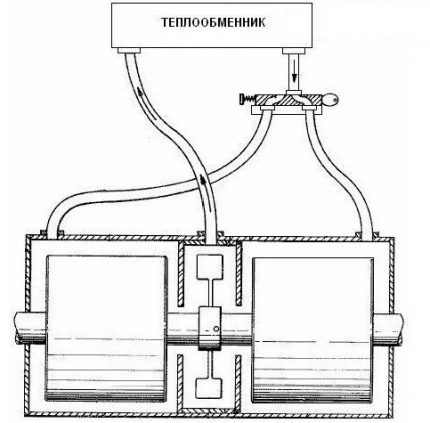
When this structure rotates, the oil heats up additionally, as it passes through special holes made in the impeller, and then penetrates into the narrow cavity between the walls of the pump casing and its rotor. Thus, the efficiency of the Frenett pump was significantly improved.
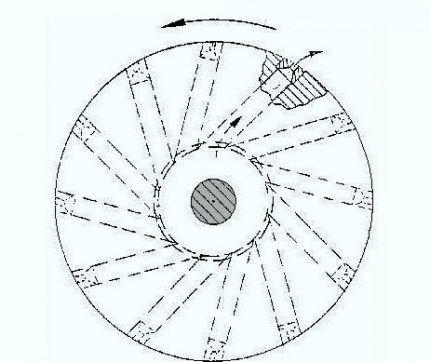
However, it is worth noting that this type of pump is not very suitable for manufacturing at home. First you need to find reliable drawings or calculate the design yourself, and this is only possible for an experienced engineer.
Then you will need to find a special impeller with holes of a suitable size. This element of the heat pump works at high loads, so it must be made of very durable materials.
Self-made device
A review of the Frenett pump device options allows us to understand that the principles of its operation with one or another degree of efficiency can be used in designs of various types and types. The basic idea remains the same: a narrow space between metal elements filled with oil, and rotation with an electric motor.

At home, a Fresnett pump is most often made, consisting of a series of metal plates separated by a narrow clearance.
To make such a device, you need to prepare the necessary materials:
- hollow metal cylinder;
- a set of identical steel disks with a hole in the center;
- set of nuts 6 mm high;
- threaded steel rod:
- electric motor with an extended shaft;
- bearing;
- connecting pipes.
Pump sizes may be larger or smaller. But the distance between the disks should be maintained exactly - 6 mm.Standard nuts are used as dividers, and the steel bar is the center of the structure.
Its thickness should correspond to the diameter of the nut. If there is no rod with a thread at hand, you just have to cut it.
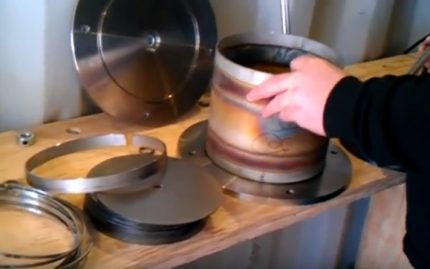
Obviously, the hole in the disks must be such that they can be freely put on the axial shaft. The outer diameter of the discs should be several millimeters smaller than the case. If there are no ready-made elements at hand, the disks are cut independently from sheet metal or entrusted with this work to a turner.

The cylindrical body can be made from an old metal container of a suitable configuration or welded from metal. Cutting a wide metal pipe is also suitable.
Walls are welded to the ends of the cylinder. The housing must be tight so that oil does not leak. Additional holes should be made in the upper and lower ends of the casing: for entering and exiting the heating pipes leading to the radiator.
Of course, all pipe joints should be sealed. For threaded connections, special seals are used: FUM tape, linen, etc. If decided use polypropylene pipes, you will need special fittings and, possibly, a soldering iron for mounting such pipes.
A high-performance electric motor is not needed for the operation of the Frenett pump. A device taken from an old or broken household appliance, such as a conventional fan, is suitable.
The main purpose of the electric motor is to rotate the shaft. Excessively fast rotation can cause the device to malfunction. The faster the structure rotates, the more the heat carrier heats up.
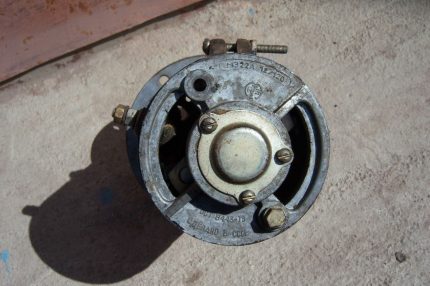
For the shaft to rotate freely, you need a suitable bearing in standard sizes. When all the elements are prepared, you can begin assembling the device. First, a central axis with a bearing is mounted on the lower part inside the housing. Then, a separation nut is screwed onto the axis, then a disk is put on, a nut again, a disk again, etc.
Discs with nuts alternate until the case is filled to the top. Even at the preparation stage, preliminary calculations can be made on the number of required discs and nuts.
It is necessary to add the thickness of the disk to the thickness of the nut (6 mm). The height of the body is divided by this figure. The resulting number will give information about the required number of pairs of “nut + disk”. Install the nut last.
After the housing is filled with these moving elements, it is filled with liquid oil. The type of oil does not matter, you can take mineral, cottonseed, rapeseed or any other oil that tolerates heat well and does not harden. After that, the design is covered with the top cover and gently brewed.
At this point, the radiator pipes are usually already attached to the covers. For convenience, during the further installation and maintenance of the device on the pipes, two stopcocks can be installed. Now you need to connect the axis of the heat pump to the motor shaft.
The system is included in the network, check for leaks, evaluate the characteristics of the device.
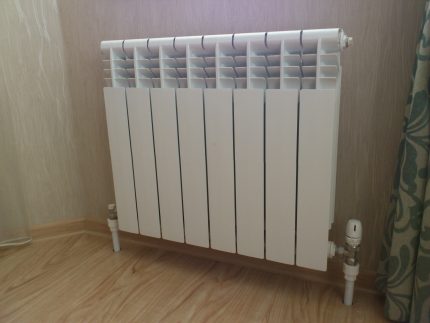
If everything is done correctly, the axis with the discs will begin to spin, warming up the oil inside the device. The hot heat carrier will move through the upper hole through the pipe to the heating radiator.Cooled oil will return to the heat pump body through the lower pipe for reheating.
To automate the operation of the system, you can use a special relay with a temperature sensor that detects the heating of the heat pump housing and turns off the engine or turns it on as needed. This will prevent overheating of the system, breakdown of the electric motor and, as a whole, will increase the life of the device.
Conclusions and useful video on the topic
An interesting version of the Frenett pump is presented in this video:
Unfortunately, the Frenett pump did not find wide acceptance in the field of heating. Such a device for industrial production for domestic use is difficult to find in home appliance stores. But many folk craftsmen successfully used the achievements of this scientist and applied them in their homes, saunas, garages, etc.
Perhaps you are the very self-made who managed to realize the idea of Frenett? Please share your experience - leave comments on the article and add photos of your products. The contact form is located below.

 Water-water heat pump: device, principle of operation, rules for arranging heating on its basis
Water-water heat pump: device, principle of operation, rules for arranging heating on its basis 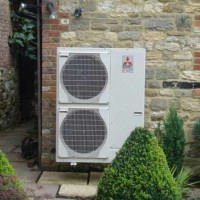 How to make a heat pump for heating a house with your own hands: the principle of operation and assembly scheme
How to make a heat pump for heating a house with your own hands: the principle of operation and assembly scheme  Air-to-air heat pump: principle of operation, device, selection and calculations
Air-to-air heat pump: principle of operation, device, selection and calculations  DIY geothermal heat pump for home heating: device, design, self-assembly
DIY geothermal heat pump for home heating: device, design, self-assembly 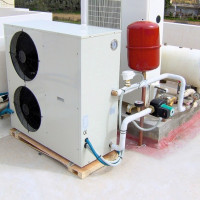 How to make an air-water heat pump: device diagrams and self-assembly
How to make an air-water heat pump: device diagrams and self-assembly 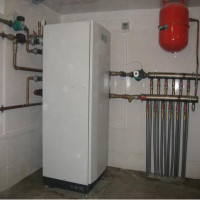 How to make a heat pump with your own hands from an old refrigerator: drawings, instructions and assembly tips
How to make a heat pump with your own hands from an old refrigerator: drawings, instructions and assembly tips  How much does it cost to connect gas to a private house: the price of organizing gas supply
How much does it cost to connect gas to a private house: the price of organizing gas supply  The best washing machines with dryer: model rating and customer tips
The best washing machines with dryer: model rating and customer tips  What is the color temperature of light and the nuances of choosing the temperature of the lamps to suit your needs
What is the color temperature of light and the nuances of choosing the temperature of the lamps to suit your needs  Replacement of a geyser in an apartment: replacement paperwork + basic norms and requirements
Replacement of a geyser in an apartment: replacement paperwork + basic norms and requirements
When the mechanisms work, friction is always present, which in the vast majority of cases is undesirable. In a car engine, for example, it is about 10%. In other devices, there may be a different percentage, but can not exceed 100% a priori, otherwise all the energy would go to heat. This is known even to the student. Therefore, such a pump is a common scam. It’s easier and easier to turn e / energy into heat directly without stupid mechanisms.
Here we have in mind the efficiency not in the physical sense (in which, of course, there can be no more than 100%), but in terms of the energy consumed by one type (electricity) to extract energy of another type. Well, for example, to light a match you strike on the boxes, using friction you create the initial heat, and then the match starts to burn and “gives” you much more energy than you spent. From the point of view of physics, of course, there is no more than one efficiency factor, but from the point of view of the energy consumer, a person, he spent much less than he received. Especially if this match will light a fire.
It’s like, instead of matches, lighting a fire with a tinder. An interesting idea, but only in terms of using mechanical energy as thermal energy, for example, from a wind turbine or a water wheel, or slaves 🙂
The conversion of electrical energy into mechanical energy and then into thermal energy is inefficient.
By striking a match, you start the process of releasing chemical energy, so the example is incorrect.
In the Carnot heat pump, heat is transferred from one part of the system to another, because there really can be obtained more heat in the receiver than the energy expended in its transfer.
There is no “transfer” of heat here - a pure conversion of mechanical energy into heat, so that there can be no talk of any “more than 100%”.
And where are the fixed disks between the spinning ones? Why not a word about them?
Because the article describes the general principle of operation of the Frenett pump, and also we are talking about schemes and some versions of homemade products. There is generally more trouble with this pump than benefits, to be honest: the equipment is unstable, it is not recommended to start work on your own, accidents are possible.
The number of stationary vortexes in a Frenett pump can be different, it already depends on what indicators need to be achieved. I will attach a part of the drawing to show in more detail the structure of such equipment. In general, all projects related to the Frenett pump are experimental. If you pour water and “go too far” with turns, then you can decompose it into hydrogen and oxygen, and this is a completely different story.